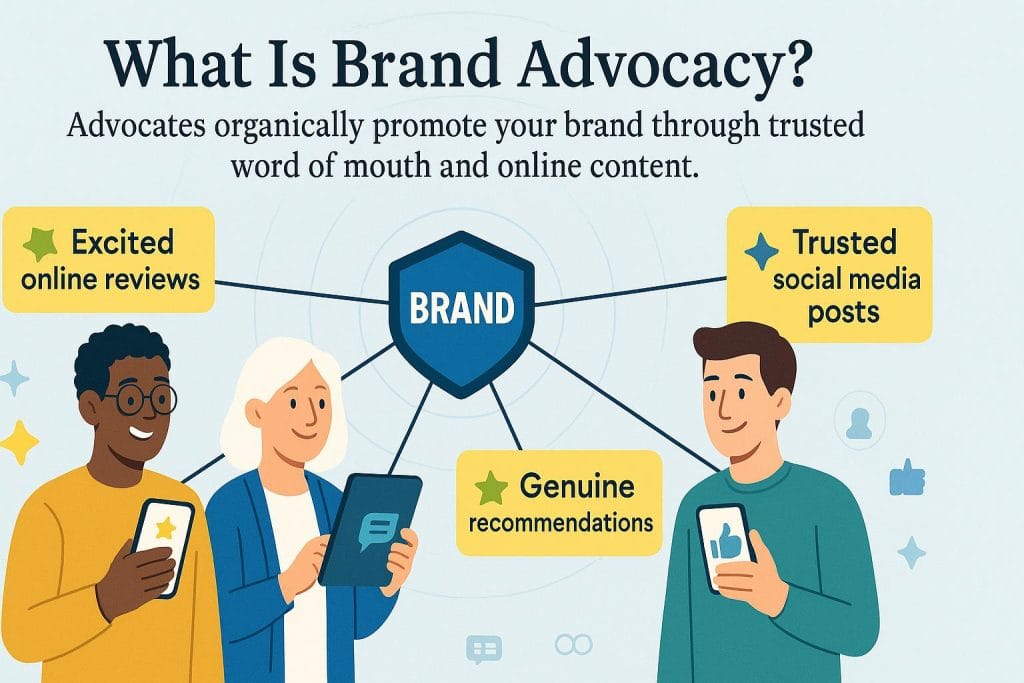Business.com aims to help business owners make informed decisions to support and grow their companies. We research and recommend products and services suitable for various business types, investing thousands of hours each year in this process.
As a business, we need to generate revenue to sustain our content. We have financial relationships with some companies we cover, earning commissions when readers purchase from our partners or share information about their needs. These relationships do not dictate our advice and recommendations. Our editorial team independently evaluates and recommends products and services based on their research and expertise. Learn more about our process and partners here.
How to Build Brand Advocacy in 6 Simple Steps
Your customers can become your biggest advocates. Here's how.

Table of Contents
Building a brand and marketing it to interested customers is crucial to any business’s success. However, many businesses overlook one of the most cost-effective marketing tools available: satisfied customers.When customers are so pleased with your products and services that they recommend your brand to others or promote it on social media, that’s brand advocacy. We’ll explore why brand advocacy is an essential marketing strategy and share how to create a brand advocacy program that encourages and rewards organic customer promotional efforts.
What is brand advocacy?

Brand advocacy happens when customer satisfaction and brand appreciation inspire people who interact with your brand to go out of their way to promote it to others. Brand advocacy can come from customers, employees, company partners, vendors and social media influencers. [Read related article: Why Responding to All Your Online Reviews Is Critical]
Brand advocates spread the word through positive online reviews posted on your website and third-party sites. They also promote your brand via word-of-mouth, social media, interviews and blog posts. These reviews, mentions, photos and comments are called user-generated content (UGC).
Organic advocacy is more influential than any paid campaign or employee messaging. If you build a strong brand advocacy program, your company can spend less on advertising and foster more engagement through UGC.
How to build brand advocacy
Some advocates will promote your brand on their own, but you can also be intentional about building an advocacy program. Here are six steps to get started.
- Identify brand advocacy drivers
- Focus on relationships
- Inspire and surprise customers and prospects
- Enable and encourage potential advocates
- Reward brand advocates' actions
- Measure the success of your advocacy campaigns
1. Identify brand advocacy drivers.
The first step is figuring out why customers love your brand and then doubling down on those strengths. Advocacy often comes from great products, but excellent customer service and personalized engagement matter just as much.
Don’t rely on guesses. Instead, gather and study customer feedback via surveys and other tools to glean insights into what you’re doing well and where you can improve. Pay attention to both praise and criticism, then use what you learn to strengthen your reputation and expand your online reach.
2. Focus on relationships.
Developing strong, personalized customer relationships is crucial for earning advocacy and driving sales. When customers feel connected and valued, they’re far more likely to recommend your brand to others. The XM Institute’s 2025 Satisfaction & Loyalty Report found that 70 percent of consumers worldwide are likely to recommend a brand after a positive experience, with advocacy rates climbing as high as 83 percent in some areas.
In other words, relationships matter: When customers feel cared for, advocacy follows.
Social media gives people an easy way to weave themselves into your brand’s story, but trust has to come first. Engagement grows when you give more than you ask, sharing meaningful content, listening to feedback and responding thoughtfully rather than pushing constant sales pitches. Over time, those genuine connections lay the foundation for advocacy.
3. Inspire and surprise customers and prospects.
Exceptional customer service can spark word-of-mouth buzz in ways that standard marketing can’t. Surprising customers with small, unexpected perks or exceptionally personalized attention can get their attention and encourage them to share their experiences. For example, you might invite your most engaged users to VIP events or send a thank-you gift to loyal followers.
McKinsey’s 2024 research shows that brands creating memorable “wow” moments often see clear gains in loyalty, referrals and even revenue growth. One proven way to spark these results is through customer delight — delivering unexpected joy and surprise that deepens emotional connections and inspires advocacy.
To capture these word-of-mouth moments, keep an eye on your reviews and social media; when you spot fans already raving, consider sending them something special. This kind of recognition helps deepen emotional connections and reinforces advocacy.
4. Enable and encourage potential advocates.
People are more likely to advocate for your brand when you make it easy and even fun to do so. For example, build simple sharing features into your social media content so customers can spread the word with a click. When they post positive reviews or shout you out online, amplify their voices by re-sharing their thoughts on your own channels.
Don’t stop there. Show your biggest fans that their support really matters. A simple public thank-you, a surprise perk in your loyalty program or an exclusive offer can go a long way toward making people feel valued. Those thoughtful touches often turn casual promoters into long-term advocates and may even inspire others to join in.
5. Reward brand advocates’ actions.
Loyalty programs often focus only on purchases, but advocacy deserves recognition, too. If you want customers to keep spreading the word, build rewards into your program for actions like writing reviews, sharing photos, attending events or referring friends.
Give your program a name that feels exclusive, and consider offering tiered benefits. Perks might include discounts, branded merchandise, early access or public recognition on your company blog or social channels. A rich, rewarding customer loyalty program is likely to pay off. According to Okendo’s 2024 Loyalty Consumer Report, 77 percent of consumers are more likely to stay loyal for the long term when a brand offers a compelling loyalty program.
These rewards send a clear message: You see and value the effort customers put into promoting your brand. That recognition helps turn casual promoters into committed advocates.
6. Measure the success of your advocacy campaigns.
Like any marketing effort, advocacy programs need tracking to prove their value. The good news is you don’t need advanced or technical tools to get started measuring and improving your marketing ROI — just a clear plan for what to watch.
Begin by looking at the basics:
- Who is creating content about your brand?
- What are they saying, and is it positive, neutral or critical?
- Where is that content being shared (social media, review sites, blogs)?
- When are people most active?
- Why are they motivated to talk about your brand?
These questions help you understand not just the volume of advocacy but the quality and reach of it.
From there, dig into your data. Website traffic, referral sources, conversions and social engagement trends can all show whether advocacy efforts are moving the needle. And remember, advocacy carries real influence: The 2025 Edelman Trust Barometer found that consumers trust their own experiences most, but the experiences of others — such as reviews and peer recommendations — strongly shape brand perception, often more than what the brand itself says.
Over time, comparing these numbers across campaigns will show you which digital marketing strategies inspire the most sharing and deliver the strongest return. That insight makes it easier to double down on what works and refine what doesn’t.
Why is brand advocacy important?
Brand advocacy is valuable because it’s authentic. While people may dismiss advertising or marketing messages, they often take enthusiastic recommendations to heart.
Here are some ways brand advocacy can help you build your brand:
- Extend your reach: Brand advocacy can expand marketing far beyond traditional limits. For example, when Adobe encouraged employees to share content online via its “Adobe Life” program, it reached millions of new audience members through authentic engagement.
- Create buzz: Positive word-of-mouth generates curiosity and can increase traffic to your website or location, helping generate leads and convert leads to sales. An increase in web traffic can also create a positive feedback loop for Google, which can boost your listing in search results and send even more traffic to your website.
- Grab media attention: Once buzz develops, brands often gain press coverage and third-party attention. This organic PR enhances credibility and increases brand awareness.
- Humanize your brand: When people hear brand stories from others or interact with employee brand ambassadors, it makes the brand relatable and memorable, especially through UGC and social brand storytelling.
- Save time and money: Investing in advocacy programs is much less expensive than traditional advertising. Advocates drive much of your marketing organically, freeing up resources for other essential business operations.
Brand advocacy is built on relationships

A successful brand advocacy strategy is rooted in relationships and two-way communication. If you cultivate engagement and reward your biggest advocates, your program will naturally generate more leads, loyalty and organic promotion.











